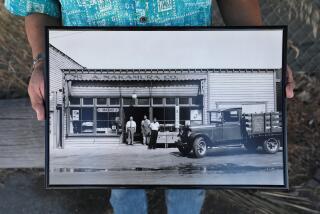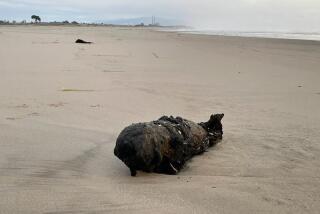Tustin gives OK to raze blimp hangar
- Share via
A historic wooden hangar that housed military blimps during World War II will be razed to make way for homes, businesses, parks and schools, Tustin city leaders decided this week.
The City Council voted unanimously Tuesday to reject proposals for a motocross facility, a culinary complex, shops catering to the elderly and a futuristic airship building center. Each would have preserved the hangar. The proposals, city staff found and council members agreed, were neither economically viable nor properly planned.
“Overall, they were very poorly done,” Councilman Tony Kawashima said. “They were not specific and didn’t comply with our questions.”
Hangar 29 is one of two blimp shelters on the former Tustin Marine Corps Air Station that are on the National Register of Historic Places. The hangars, more than 1,000 feet long, 300 feet wide and 170 feet high, are the world’s largest all-wood buildings, according to Paul Freeman’s “Abandoned & Little-Known Airfields” website.
The hangars were built in 1942 for Navy blimps that prowled the Pacific coast for Japanese submarines. After World War II, the base was largely idle until the Korean War, when it became the Marine Corps’ primary West Coast helicopter base. The base was closed in 1999, and the military entered into an agreement with the city and Orange County to allow the redevelopment of the land and hangars. The second hangar, which is on county land, is being turned into a sports and entertainment complex.
The developers who were turned down by the Tustin council were angry Wednesday, saying the city never seriously considered their proposals.
Shaheen Sadeghi, who created the Lab and the Camp shopping centers in Costa Mesa, had proposed building within the hangar a culinary community, which would have included a cooking school, artisan food shops, gourmet cafes and a year-round farmers market. He said city officials should have collaborated with developers and the community to figure out the best use for the hangar.
The vote “was just an exercise. They probably had a very good idea they didn’t want to save the building and went through the motions,” he said.
“Orange County needs as many iconic buildings as possible, because we don’t have much of a history. Why tear it down and put up another retail center or office complex? I don’t think anyone needs us to build another Starbucks “
He said that city estimates that refurbishing the hangar would cost tens of millions of dollars were short-sighted because an interesting redevelopment project would eventually bring much more sales tax revenue into city coffers.
Lance Brown of Aliso Viejo, one of the backers of the motocross facility, said he had lined up $42.5 million in financing from the motorcycle industry.
Council members “don’t have the sense that there are young people in their neighborhoods that need something to do,” he said. “I don’t think they ever had any intention of allowing a reuse of the hangar.”
City officials said that was untrue.
“It was a very lengthy process with many steps that the city took very seriously,” said Lisa Woolery, city spokeswoman.
She added that the Navy and the State Office of Historic Preservation agreed that none of the projects were economically viable. City consultants found the proposals flawed and incomplete, with applicants submitting 6% to 38% of the required information.
“That’s an important indication as to how seriously they took it,” Woolery said.
The land on which the hangar sits will be leased and eventually sold to the Tustin Legacy Community Partners, the development company that is building 2,105 homes, businesses, schools and parks on 822 acres at the former military base. The hangar will probably be torn down in five or six years, after the Navy cleans up contaminated water beneath it.
The council also decided Tuesday to join the county in spending $127,000 to create a written history, exhibit and video of the base highlighting the hangars’ history, as required by the city’s 1999 agreement with the Navy.
More to Read
Sign up for Essential California
The most important California stories and recommendations in your inbox every morning.
You may occasionally receive promotional content from the Los Angeles Times.











